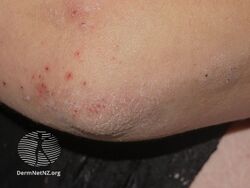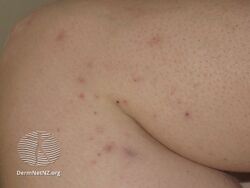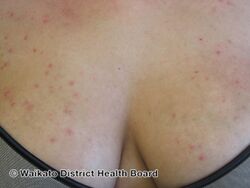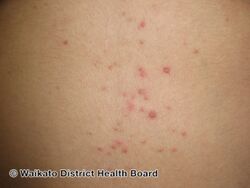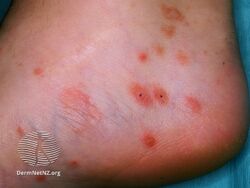Prurigo of pregnancy
| Prurigo of pregnancy | |
|---|---|
| Other names: Prurigo gestationis of Besnier;[1] early-onset prurigo of pregnancy;[2] linear IgM dermatosis of pregnancy;[2] papular dermatitis of pregnancy;[2] Spangler's papular dermatitis of pregnancy[2] | |
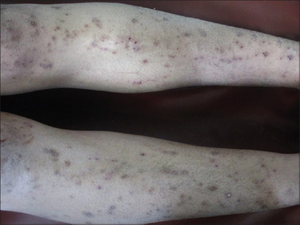 | |
| Prurigo of pregnancy in 29-year-old multigravida | |
| Specialty | Dermatology, obstetrics |
| Symptoms | Itchy, small bumps on the arms, legs, and trunk[3][4] |
| Usual onset | 20 and 34 of pregnancy[5] |
| Duration | Up to 3 month following the end of pregnancy[6] |
| Causes | Unclear[7] |
| Risk factors | Prior history of eczema[6] |
| Diagnostic method | Based on symptoms and examination after ruling out other possible causes[8][6] |
| Differential diagnosis | Intrahepatic cholestasis of pregnancy, scabies[6] |
| Treatment | Steroid cream, antihistamines, benzoyl peroxide, UVB light[8][5][6] |
| Frequency | 1 in 300 pregnant women[4] |
Prurigo of pregnancy is a skin condition of pregnancy that results in itchy, small bumps on the arms, legs, and trunk.[3][4] These occur in small groups and scratching results in excoriation.[4][6] Onset is generally between week 20 and 34 of pregnancy.[5] It does not result in risks for the baby.[4][5]
The exact cause is unclear, but it likely a flare of eczema.[7][5] Risk factors are believed to include a prior history of eczema.[6] Diagnosis is generally based on symptoms and examination.[6] It is considered a diagnosis of exclusion.[8] It includes the conditions known as Besnier's prurigo gestationis, Nurse's early-onset form of prurigo, and Splangler's paupalar dermatosis of pregnancy.[6] It is type of atopic eruption of pregnancy (AEP), together with eczema in pregnancy and pruritic folliculitis of pregnancy.[9]
Treatment is with steroid cream.[5] Antihistamines may also help.[6] Other options may include benzoyl peroxide and UVB light.[8] Outcomes are good, with symptoms resolving within three months after pregnancy; though it may reoccur in future pregnancies.[6] Prurigo of pregnancy affects about 1 in 300 pregnant women.[4] It represents about 6% of rashes due to pregnancy.[6] The condition was named in 1904 by Ernest Henri Besnier.[6]
Signs and symptoms
See also
References
- ↑ Ambros-Rudolph CM, Black MM, Vaughan Jones S (29 August 2008). "9. The Papular and Pruritic Dermatoses of Pregnancy". In Black MM, Ambros-Rudolph C, Edwards L, Lynch PJ (eds.). Obstetric and Gynecologic Dermatology E-Book. Elsevier Health Sciences. pp. 73–77. ISBN 978-0-7234-3445-0. Archived from the original on 24 March 2022. Retrieved 26 February 2022.
- ↑ 2.0 2.1 2.2 2.3 Rapini RP, Bolognia JL, Jorizzo JL (2007). Dermatology: 2-Volume Set. St. Louis: Mosby. ISBN 978-1-4160-2999-1.
- ↑ 3.0 3.1 Kurien, G; Badri, T (January 2023). "Dermatoses of Pregnancy". PMID 28613614. Archived from the original on 30 June 2023. Retrieved 16 December 2023.
{{cite journal}}: Cite journal requires|journal=(help) - ↑ 4.0 4.1 4.2 4.3 4.4 4.5 Roth, MM (1 February 2011). "Pregnancy dermatoses: diagnosis, management, and controversies". American journal of clinical dermatology. 12 (1): 25–41. doi:10.2165/11532010-000000000-00000. PMID 21110524.
- ↑ 5.0 5.1 5.2 5.3 5.4 5.5 James, William D.; Elston, Dirk; Treat, James R.; Rosenbach, Misha A.; Neuhaus, Isaac (2020). "21. Chronic blistering dermatoses". Andrews' Diseases of the Skin: Clinical Dermatology (13th ed.). Edinburgh: Elsevier. p. 466. ISBN 978-0-323-54753-6. Archived from the original on 2023-07-01. Retrieved 2023-05-15.
- ↑ 6.00 6.01 6.02 6.03 6.04 6.05 6.06 6.07 6.08 6.09 6.10 6.11 6.12 Ingber A, Lebwohl M (18 December 2008). Obstetric Dermatology: A Practical Guide. Springer. pp. 151–. ISBN 978-3-540-88398-2. Archived from the original on 24 March 2022. Retrieved 9 May 2010.
- ↑ 7.0 7.1 Sterry W, Paus R, Burgdorf WH (8 March 2006). Dermatology. Thieme. pp. 331–. ISBN 978-1-58890-258-0. Archived from the original on 24 March 2022. Retrieved 9 May 2010.
- ↑ 8.0 8.1 8.2 8.3 Horn TD (2003). Dermatology. Elsevier Health Sciences. pp. 454–. ISBN 978-0-323-02578-2. Archived from the original on 24 March 2022. Retrieved 9 May 2010.
- ↑ Stefaniak, AA; Pereira, MP; Zeidler, C; Ständer, S (March 2022). "Pruritus in Pregnancy". American journal of clinical dermatology. 23 (2): 231–246. doi:10.1007/s40257-021-00668-7. PMC 8860374. PMID 35191007.
